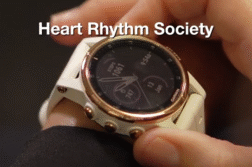MIAMI, Fla. (Ivanhoe Newswire)— A routine procedure used to treat cancer patients has become a groundbreaking tool to save a heart patient’s life. Radiation is commonly used to shrink tumors, but in a procedure only done in a few centers around the world, doctors are finding out it can also be used to treat an irregular heartbeat.
Just months ago, Jose Garcia was critically ill. The 77- year old’s irregular heartbeat kept him in and out of the hospital.
“He was too sick to undergo any type of invasive intervention,” recalled Mario Pascual, MD, an electrophysiologist at Baptist Health’s Miami Cardiac & Vascular Institute.
So, doctors at Baptist Health in Miami decided to treat Garcia with a procedure that targets tumors in cancer patients. It’s called stereotactic radio ablation.
“Essentially, it is giving a very high dose of radiation therapy, in one treatment, very precisely, to the part of the heart which was causing his arrhythmia,” described Rupesh Rajesh Kotecha, MD, a radiation oncologist at Baptist Health’s Miami Cancer Institute.
The procedure only took 20 minutes but planning and coordinating took weeks.
“An electrophysiologist is involved, a general cardiologist, a cardiac imaging specialist, an advanced heart failure specialist. And then, you have to collaborate with a radiation oncologist on top of that,” added Pascual.
Weeks after his treatment, Garcia can wheel his wife of 52 years in with him to follow-up visits. He is looking forward to the future with his three kids and four beautiful grandchildren.
“It’s a big difference between the past and a treatment that is a half-hour. Unbelievable, unbelievable,” Jose Garcia shared.
The Florida doctors consulted with experts at Washington University School of Medicine in Saint Louis, who have previous experience using this technique in heart patients. Doctors at Baptist Health say more research needs to be done, but they are pleased with Jose Garcia’s results.
Contributors to this news report include: Cyndy Mcgrath, Executive Producer; Neki Mohan, Field Producer; Judy Reich, Videographer; Roque Correa, Editor.
To receive a free weekly e-mail on medical breakthroughs from Ivanhoe, sign up at: http://www.ivanhoe.com/ftk
Sources:
MEDICAL BREAKTHROUGHS
RESEARCH SUMMARY
TOPIC: CANCER PROCEDURE SAVES HEART PATIENT
REPORT: MB #4898
BACKGROUND: Stereotactic ablative radiotherapy (SABR), also known as stereotactic body radiation therapy (SBRT), is a highly focused radiation treatment that gives an intense dose of radiation concentrated on a tumor, while limiting the dose to the surrounding organs. It has become a treatment of choice for many people with limited volume tumors for whom surgery may not be an optimal treatment. Advantages of using SABR is that it is highly effective and accurate. For most indications, local tumor control rates of 90% can be achieved. SABR uses the latest image guidance technologies to ablate tumors with millimeter-scale accuracy. The ability to spare healthy tissue while intensifying the radiation dose is the primary advantage of SABR over other modalities, particularly when critical structures are located near the treatment area. SABR is also non-invasive and comfortable for the patient. A majority of SABR treatments are done as short outpatient visits of 30 minutes to an hour, requiring no hospitalization.
Preparing for Surgery: Planning begins with diagnostic imaging to help locate the tumor and determine the area that will be treated. This includes four-dimensional imaging that maps the target area as it moves over time with the patient’s breathing cycle. In the only invasive part of the treatment, gold seeds, called fiducials, are sometimes implanted into the tumor before images are taken. Because the fiducials are visible in planning scans and at the time of treatment, physicians use them to ensure that the high-dose envelope of radiation is accurately overlying the tumor. Radiation oncologists work with medical physicists to develop a radiation plan that ensures safe exposure to normal structures. Each of the treatment sessions takes 30 to 60 minutes and, unlike more invasive therapies, the patient leaves each treatment free of significant pain or side effects. Treatments do not have to be administered on consecutive days, but the entire course of therapy is usually done within 10 days.
(Source: https://www.uclahealth.org/radonc/faqs-sbrt)
Promise and Future Directions of Stereotactic Radio Ablation: Ventricular tachycardia (VT), an important cause of mortality and morbidity, commonly occurs in the context of structural heart diseases. Recent progress in cardiac imaging and electroanatomic mapping techniques have prompted the use of catheter ablation for VT substrates delineation and ablation. Antiarrhythmic drug therapy and catheter ablation are the foundation of VT management, but both treatments have limited efficacy and potential adverse effects. Also, despite significant progress in catheter ablation efficacy, the recurrence rate after a first VT ablation is about 50%, which exposes patients to multiple catheter ablation procedures and implantable cardioverter-defibrillator (ICD) shocks. Stereotactic radiotherapy, routinely used in the realm of oncology to non-invasively treat solid tumors with high precision and efficacy, appears as a new tool in VT management.
(Source: https://www.frontiersin.org/articles/10.3389/fcvm.2020.00108/full)
FOR MORE INFORMATION ON THIS REPORT, PLEASE CONTACT:
VICTORIA VERDEJA
(833) 692-2784
If this story or any other Ivanhoe story has impacted your life or prompted you or someone you know to seek or change treatments, please let us know by contacting Marjorie Bekaert Thomas at mthomas@ivanhoe.com




